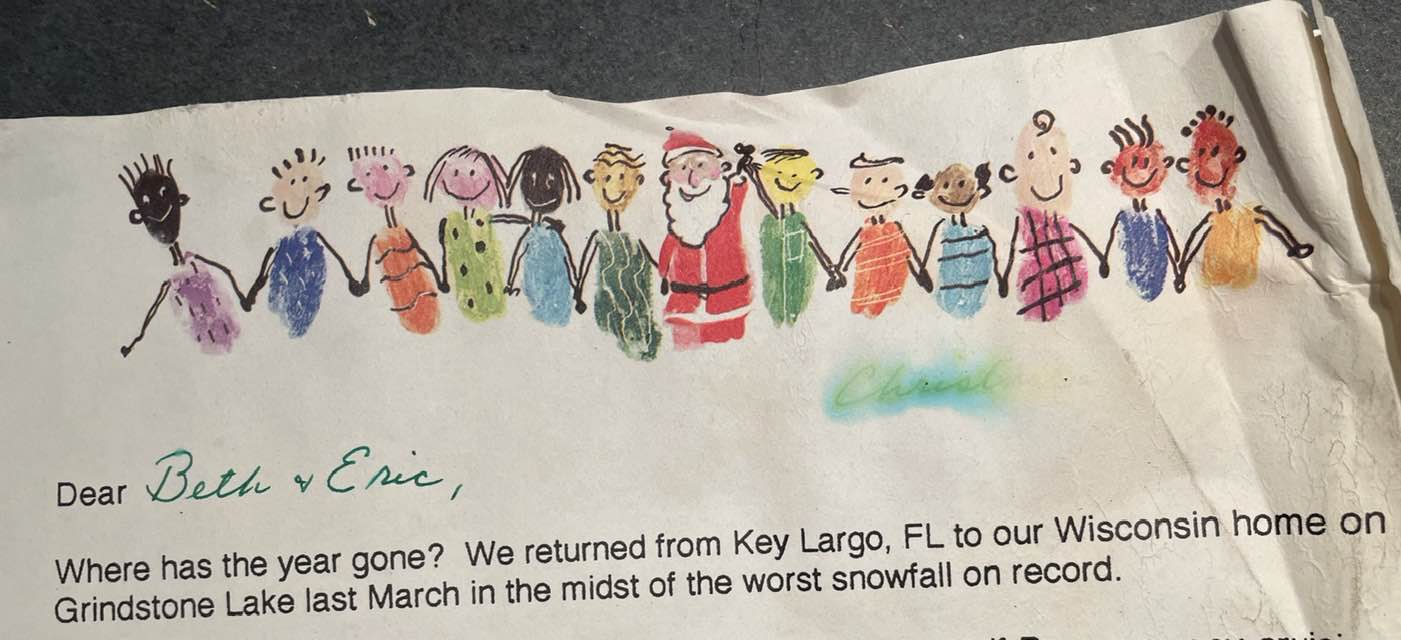NOVEMBER 9, 2022 – The directive was clear. Soon after Beth had left this morning in search of more inventory for her online-used book sales, she sent me a text: “Could you please try and get your car in the garage today.” Implicit was the sub-directive (or was it the main directive?): clear out all the crap from “my half” of the garage.
As an alternative to watching the paint dry on political races “too close to call,” I dutifully consolidated scattered “stuff” and moved a few of Beth’s encroaching shipping boxes to “her half” of the garage. While engaged in this clean-up operation, I uncovered several sheets of paper lying face down on the garage floor. They were Christmas letters we’d received a thousand years ago; no doubt they’d fallen out of one of the Christmas boxes that are stored in the attic above the garage.
One letter was from Randy and Joanna Rovelstad, my parents’ closest neighbors up at the lake. Randy was a retired Mayo internist; his wife, the daughter of George and Ebba Campbell, who owned the land adjoining the east end of Björnholm and had built their summer cabin in 1926—14 years before my grandparents built our family cabin.
The letter bore no date, but judging by the family news that it imparted, it was likely from the early 1990s. Almost 30 years ago, I said to myself, nearly aloud. Type-written, single-spaced, and filling a single page, the Yuletide missive reflected Joanna’s distinctive voice. Her references to Randy brought him alive, as well. For more than a decade, both have been gone from this world; hard to believe, considering how long they’d occupied it.
I’d known three generations of Joanna’s family, and the letter brought back many memories of interactions between our clans. I felt as though I’d opened a dusty trunk in the attic. Once disturbed, the old trunk wasn’t in a rush to reclaim its exposed cache of memories. I was left to contemplate them against the backdrop of a fast-spinning world.
As I swept the garage floor, I recalled George, the patriarch. He was a tall, handsome, white-haired man, my grandfather’s age, laconic but kind, whose patented response to everything that I said was, “Is that so-o-o”—uttered without him moving his lips. His approach to retired cabin-life was similar to Grandpa’s: an endless series of maintenance projects interrupted regularly by cutting, splitting, and stacking firewood. In the case of each man, hard, productive, satisfying work was his version of recreation. Fishing? As long as you ate what you caught, that was putting food on the table.
If George and Grandpa had plenty in common, back at our cabin Grandpa occasionally made unflattering remarks about George being “as cheap as the Scotsman that he was.” Grandpa explained that the name “Campbell” made George a Scotsman. It wasn’t clear to me as a young kid, however, what made George “cheap”—though by way of the Gold Bond trading stamps that my mother allowed me to lick and paste into little redemption booklets, I was aware that “Scottish” went with “saving,” thanks to the Gold Bond mascot—a kilt-clad character, who, my mother explained, was Scottish and was named, “Sandy Saver.” (Cont.)
(Remember to subscribe to this blog and receive notifications of new posts by email.)
© 2022 by Eric Nilsson
